Humewood Golf Club
Eastern Cape, South Africa
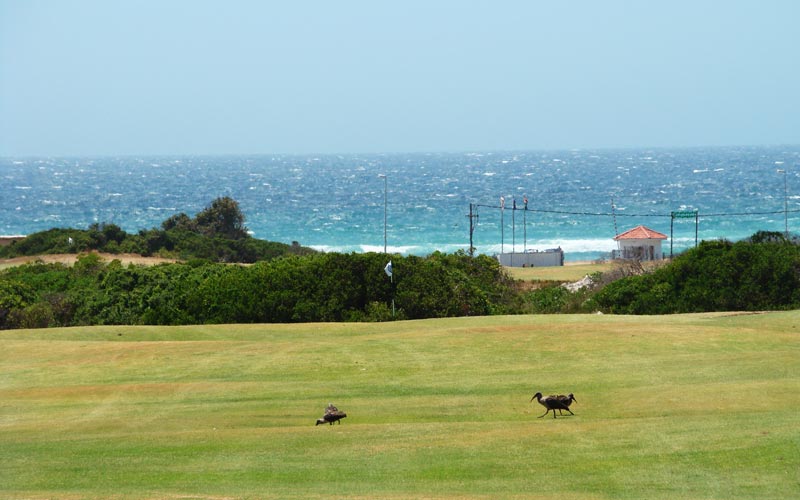
When many of the golfing countries in North America are dull and grey, the charms of Humewood become particularly acute. The above photograph looking down the ninth fairway and out to Algoa Bay was taken in February.
As the game of golf developed, so to did its architecture. Knowledge on the subject emanated from the United Kingdom in various ways with its golf professionals first traveling across the English Channel. Though rudimentary in nature, early British resort courses like Pau in the 1860s and Biarritz in the 1880s proved successful, which emboldened golf professionals to go further afield. The Scottish invasion of North America led by Willie Dunn, Willie Davis and Willie Campbell gave the game in Canada and the United States of America a boost forward in the 1880s and 1890s. Their courses were interesting enough to allow newcomers to foster a liking for the game at key clubs like Royal Montreal, Shinnecock Hills and The Country Clubin Brookline.
Importantly, amateur enthusiasts soon helped golf course architecture reach another, higher level.The knowledge that Charles Blair Macdonald, A.W. Tillinghast and Stanley Thompson garnered by seeing the great British links proved invaluable to their later work in North America. Likewise, trips to the United Kingdom by businessmen including George Crump, Hugh Wilson andHenry Fownes were instrumental in the founding of several North American cornerstone designs.
During this age of travel and the sharing of ideas, the likes of Bernard Darwin and Horace Hutchison carefully chronicled the advancements in golf course architecture. By 1925, the Golden Age of golf course architecture was well advanced across the United Kingdom, Ireland, Europe and North America.
The same cannot be said for the southern hemisphere. Yes, the Brits brought golf to growing countries like Argentina when they came to assist with their infrastructure requirements such as railways. For instance, Mar del Plata opened for play in 1881 and remains a wonderfully fun course to this day. However, to call it a great design is ambitious and it took a golf course architect (the expression was coined by Macdonald in 1908) to provide architecture in the southern hemisphere with a much needed shove forward. The time was 1926 and Alister MacKenzie’s trip down under to Australia and New Zealand forever set a new standard for golf course design, especially in that part of the world. Three years later, MacKenzie was again south of the equator, this time primarily in Buenos Aires building thirty-six holes at the stylish Jockey Club.
While MacKenzie was in South America, another great British architect was making his own mark in the southern hemisphere and that was Major Stafford Vere Hotchkin in South Africa. According to historian Tom MacWood, Major S.V. Hotchkin’s arrival in 1929 came at a crucial time and did for South Africa what MacKenzie’s trip meant to Australia.
MacWood is quick to point to the importance of Dr. Charles M. Murray in getting Hotchkin to South Africa. Murray had studied in Britain and upon his return in South Africa in 1904, began his lifelong interest in agronomy and golf course architecture. After a tour by top British amateurs to South Africa in 1928, Dr. Murray wrote that, ‘Unless we move with the times and so modify our links as to afford a standard of play as is called for on the courses over which first-class events are played today in other parts of the world, it is obvious we cannot hope to produce golfers capable of holding their own in championship golf. That Australia has realized this is shown by the fact that during the last few years the leading clubs have been busy carrying out very drastic alterations to their links under the supervision of well-known architects.’
Murray’s clamoring that South African golf was inadequate paid off the following year. When Port Elizabeth Golf Club decided to build a new links within five hundred yards of the shoreline in the Eastern Cape, they reached out to the United Kingdom for one of its best. The timing suited Hotchkin better than either of his design partners, Cecil Hutchison or Sir Guy Campbell, and off he went from England by steamer to South Africa.
According to MacWood, Hotchkin’s initial inspection of golf courses in South Africa confirmed what Murray contended. Essentially, the design of the courses was more akin to where the United Kingdom stood in the 1890s with the gutta-percha ball. Poor bunkering and square greens created little strategic interest. Straight holes abounded with few doglegs or interesting playing angles. Presented in such a blunt manner, the game’s appeal was limited. Indeed, what a pity it would have been to squander the opportunity to build world class golf in South Africa, given its climate, abundant coastline and sandy soil.
Fortunately, Hotchkin was about to change all this when he was given his greatest blank canvas with which to work at Humewood Golf Club. MacWood shares this telling quote from Hotchkin himself:
‘On my arrival these enthusiasts immediately took me out to view the ground, and I expected to see rolling sand dunes and glass-clad valleys; instead I was first taken over some rocky scrubby ground, then through dense scrub, and later having fallen into many holes, torn my clothes, and missed treading on several snakes, I arrived breathless and heated on a small sand dune. When I recovered my breath, I at once agreed with my guides that it certainly was a most wonderful piece of golfing ground, and that without any assistance from man, nature had produced ground which would not only defeat but instill respect in the best golfers. Wonderful to relate, when work was once started, in under three months a desert of scrub and sand was turned into an eighteen-hole golf course; not only was the ground prepared but all fairways and greens panted, a road constructed to the clubhouse, and wells sunk for providing water. The links are constructed on beautiful undulating sand dunes overlooking the sea, and the lay-out is absolutely modern and up to date. The club house is centrally situated with nine holes on each side of it, the 18th green being in front of the club house, and 9th green and 1st and 10th tees close to it. But providing the grass does grow well–and I understand that no fears are entertained on this score by those who have gone into the matter since water has been struck close to the surface several places– I feel justified in predicting that the Humewood Course will prove fully the equal of first-class championship seaside courses in Britain.’
Before building Humewood Golf Club, Hotchkin’s most prominent design was Woodhall Spa in Lincolnshire, England. His grandfather had actually started the spa in 1840 but work carried out to the golf course by Cecil Hutchison and Hotchkin in 1920s had made it one of the country’s foremost inland designs. Nothing about Woodhall Spa is contrived or forced upon the landscape. Its hazards are well placed and appear as part of nature. Its bunkers are famously deep and they dictate the playing strategy on numerous holes. All of this was a portent to what Hocthkin would bring to South Africa. By doing so, Hotchkin, more so than any other person before or after, helped South Africa realize its golfing potential.
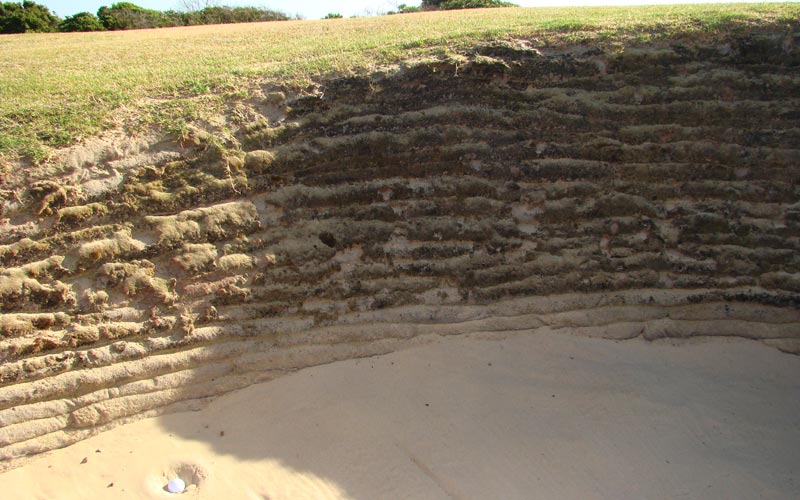
Though there are only forty-five bunkers at Humewood, they are well placed and act as true hazards.
Port Elizabeth is known on the continent as the Windy City and there is no shelter from it on this exposed links. Safe to say, Humewood Golf Club‘s crumpled sandy landscape and wind are at the core of its challenge and Hotchkin’s routing took maximum advantage of both attributes.His routing does not follow the classic out and back routing of the Old Course at St. Andrews, a course that he adored above all others. Rather, the stately clubhouse was located in the middle of the property with the first nine looping to its north and the second nine to its south. The majority of the holes feature broad playing corridors that run in a general east/west direction within the club’s rectangular property. In relation to the par threes, Hotchkin made sure that each of the four played in different directions.
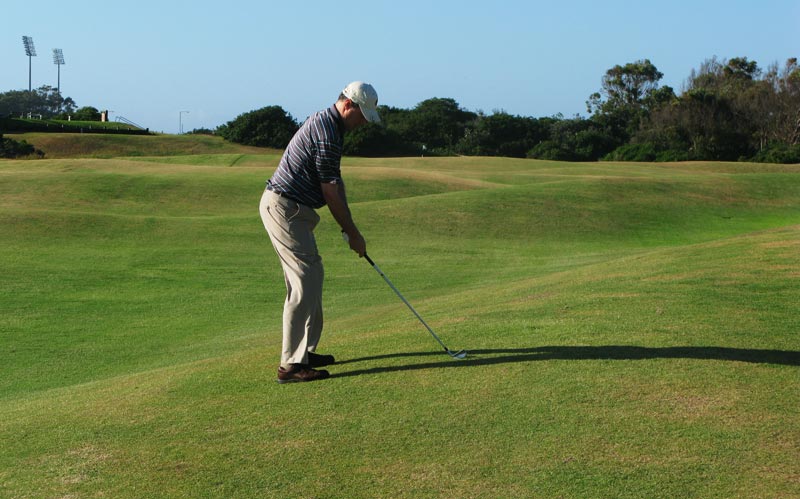
Every aficionado of links golf relishes such awkward stances as they keep the game forever fresh. Pictured above is a long iron approach to the tenth green.
On windy days, Humewood Golf Club is a ferocious test which is one of the reasons why it has hosted five South African Opens and nine Amateurs. Importantly for the joy of the members, the club has done an excellent job over the decades in maintaining width in its playing corridors. The fairways are appropriately wide and the rough is such that golfers can generally find their ball without undue delay and at least advance it back onto the fairway. Some modern courses in South Africa suffer from thick choking rough from which there is no recovery, inadvertently snuffing the joy out of a game. Humewood Golf Course‘s rough is sparse enough to dole out a ½ stroke penalty while still allowing the golfer to enjoy a sense of continuum in his round. Of course, if the golfer strays forty plus yards off line and into the coastal bush, the fates aren’t as kind.

Stray up to twenty yards off the fairways and the golfer finds a wide variety of lies, which is exactly as it should be.
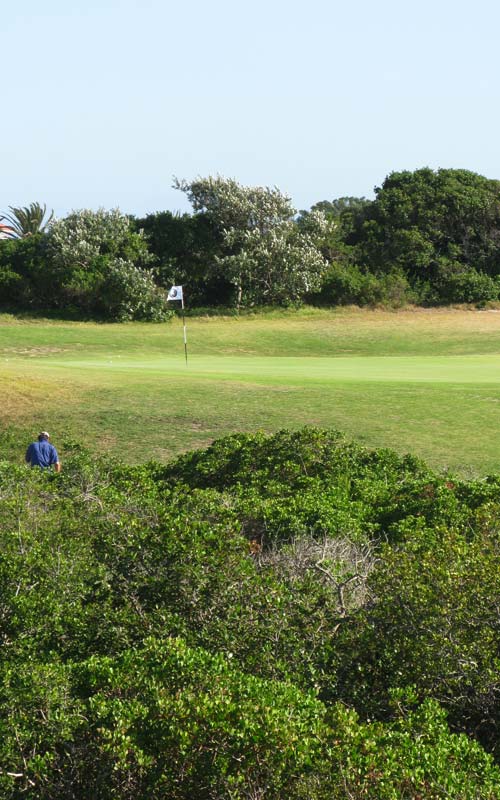
Stray further and the coastal bush provides a more certain outcome!
Though Donald Steel consulted here in 1990s and added several bunkers among other tweaks, Hotchkin’s routing has remained untouched for nearly eighty years. All eighteen of his green sites are still in use from when play first commenced here in 1931, which is testimony to the quality of the green complexes. As at Woodhall Spa, theydon’t feature a tremendous amount of interior contours within the putting surfaces but rather are notable for the wide variety of approach (and recovery!) shots that they call for.
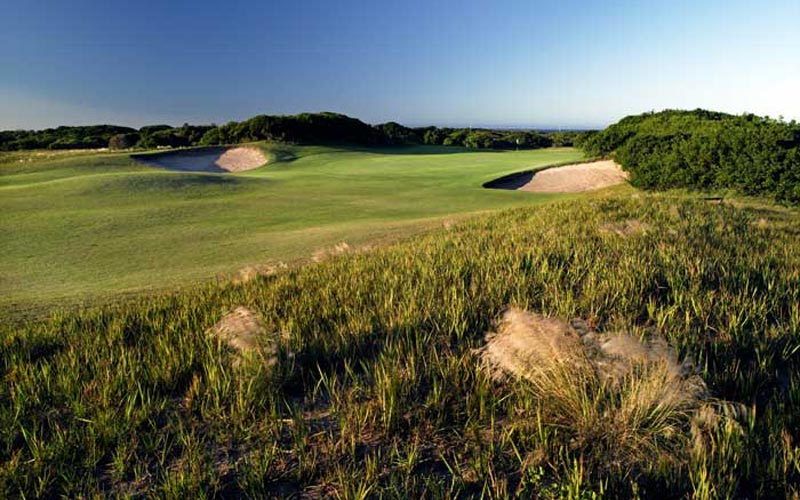
Some of the greens like the twelfth and here at the fifteenth as captured by photographer David Scaletti are tucked into the bush covered dunes while…
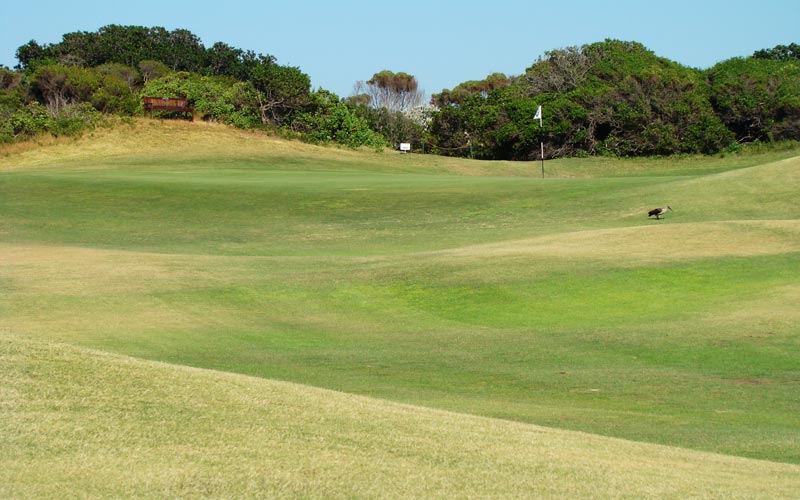
…others like the thirteenth are high on plateaus. Every green is open in front so the golfer is free to decide whether a low running or aerial approach makes the most sense given the day’s wind.
A closer study of the holes below highlights the range of shots that the golfer can expect during his round. There is not a lot of visual trickery and indeed first glance might suggest the green complexes are a bit simple by today’s standards; in fact, nothing is farther from the truth as they possess outstanding golfing qualities of the sort that no one tires of playing.
Holes to Note
First hole, 400 yards; Is there any more enticing prospect from a first tee than one of a wide fairway that runs downhill toward the sea? Such is the case here and in addition, the wind is generally from behind which is to say that the prevailing wind blows toward Algoa Bay. Of course, the wind can blow from any direction and when it comes in off the sea, a hole like the first becomes formidable as it did in 1979 when Humewood Golf Club hosted the South African Amateur.On his way to winning, Louis Norval played David Frost in the semifinals and their match was extended to a nineteenth hole. When Frost’s long iron approach was blown right into the coastal shrub, Norval saw his opening. Golf is cruel though and despite knowing that was the one place not to go, Norval was too kind and followed suit. After they hacked out and onto the green, Frost’s putt from twelve feet missed and Norval won when he managed to make his six footer. Played downwind, these two great golfers would normally have only a short iron for their approach. However, normal is relative at Humewood Golf Course as is evidenced by their need to punch in long irons under the wind that day.
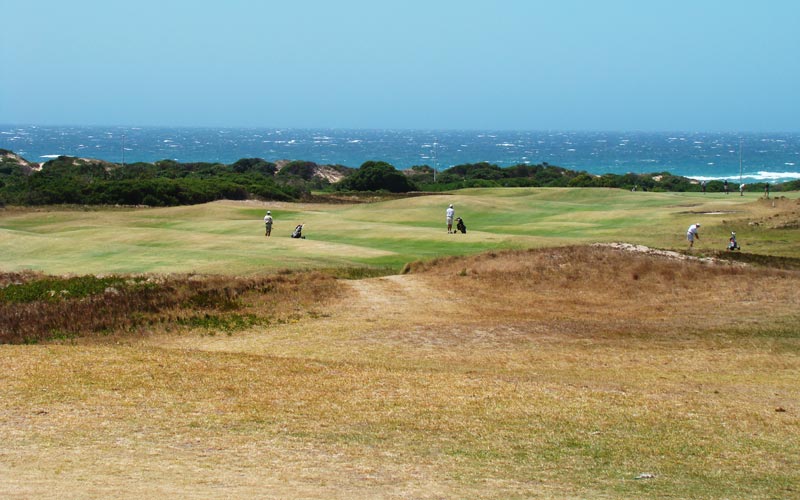
Anyone for golf? If this view doesn’t stir passion, one should find an alternative sport.
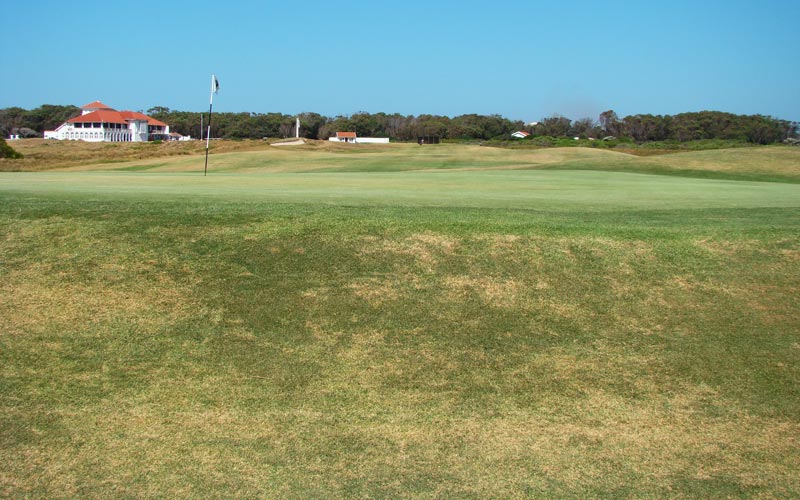
A view from behind the first green is a good indication of how the pushed-up greens often feature tightly mown slopes that fall away around the sides and back.
Second hole, 435 yards; Humewood Golf Course is not laid across dramatic tumbling land akin to some of the Irish links like Lahinch or Ballybunion. Rather, its dune landforms rarely climb higher than ten feet, which in many ways though may actually be better suited for the sport of golf. On the first nine, the tallest row of dunes is found here and to no one’s surprise, Hotchkin perfectly captured it by bending the second fairway from right to left around it. How much the golfer dares bite off varies with his own game and the day’s wind.
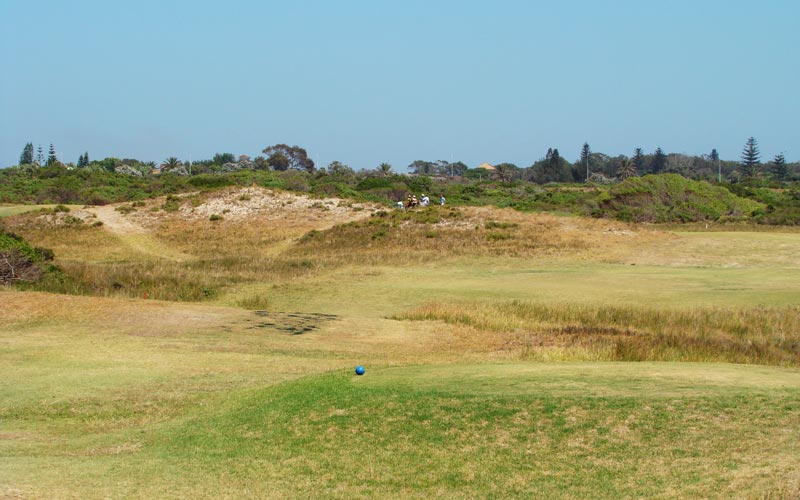
The aggressive line off the second tee is over the dunes toward the players in the distance. One of Hotchkin’s primary criticisms of South African golf was a lack of doglegs and the new design standard that he set at Humewood successfully addressed that issue.
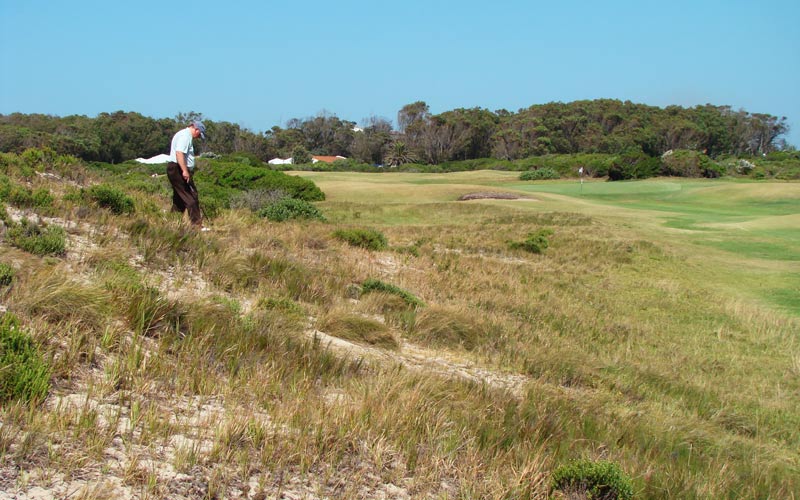
This golfer was a bit too aggressive/optimistic off the tee and was left with an awkward recovery shot.
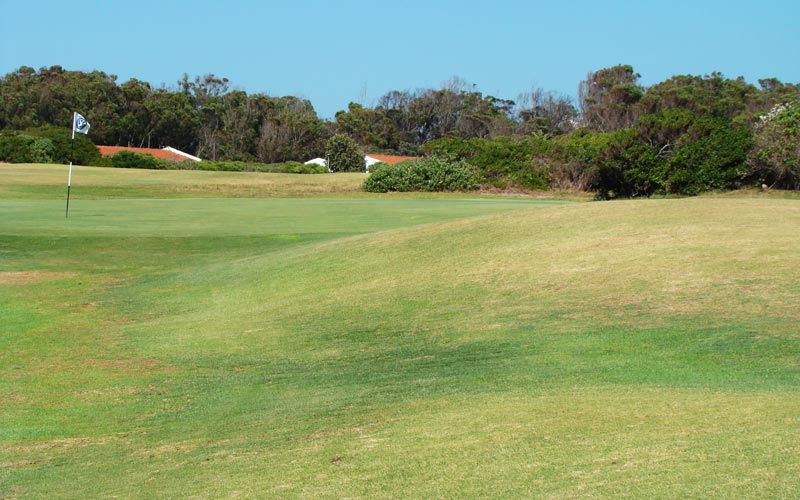
The dogleg nature of the second means that the approach is often played back into the wind and this mound might well be used to kick low scooting approach shots in toward such forward hole locations.
Humewood Golf Club
Eastern Cape, South Africa
Third hole, 220 yards; One tenet of good design that the Golden Age architects embraced from time to time was the notion of building hazards on only one side of the green. The skilled golfer who takes on the challenge is rewarded while those less accomplished are given plenty of room on the other side of the green to work the ball in. This concept is sadly absent from many modern courses in South Africa where bunkers guard the left and right of greens, effectively leaving the golfer little strategy to mull over other than to hit the green. This long par three is a fine case in point with two bunkers right of the green and a low row of mounds left that the golfer can use to feed balls down onto the putting surface.
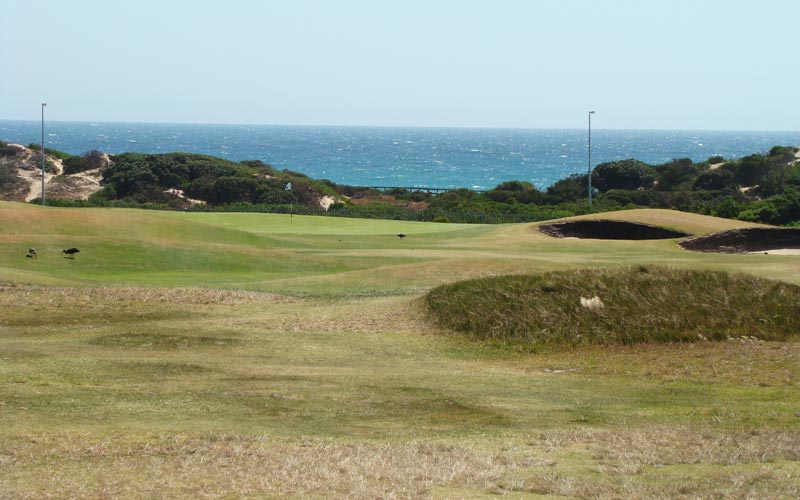
The most direct route is to aim at the right center of the green. Golfers who choose that way also enjoy the most predictable bounces onto the green. Nonetheless, it brings the two pot bunkers into play. Better yet is to perhaps play one’s tee ball just inside the distant left telephone pole in hopes of catching the slope and having one’s tee ball feed right onto the putting surface.
Fourth hole, 430 yards; The well conceived bunkering pattern lends this dogleg left its strong character. Two deep greenside bunkers mean that this angled green is best approached from the outside of this dogleg, which, of course, is where two bunkers are found.
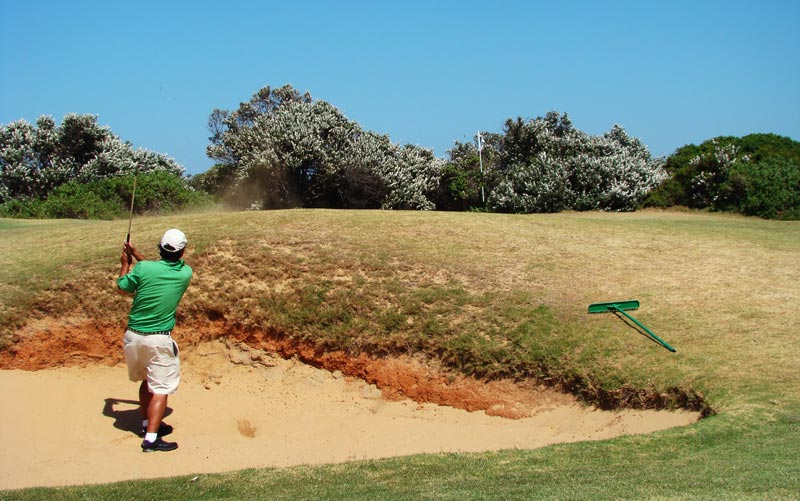
Especially when played into the prevailing wind, carrying the left greenside bunkers can be an heroic task.
Fifth hole, 415 yards; There is nothing cluttered about Humewood’s design and indeed, its simplicity makes plenty of modern designs look like they are trying too hard. Sometimes like standing on the fifth tee, the the golfer may be lulled into a false sense of comfort by the fairway’s width. Not unlike Augusta National (at least in its initial form), Royal Melbourne and a host of other Golden Age design, there is frequently a preferred spot within the wide fairway from which to approach certain hole locations.Such is the case here with the pushed-up green pad being one of the very best on the course. Featuring sharp fall-offs left and right alongthe length of this narrow green, only approach shots that are played from the right center of the fairway (i.e. from near the only fairway bunker) enjoy a good look down the throat of the green. Approach shots played from the left side of the fairway come in at an oblique angle with a common result captured in the photograph below.

Typical of many an approach shot into the fifth, this one didn’t quite reach the putting surface and rolled down to the base of the built-up green pad, leaving the golfer with several interesting recovery options. This green complex appears natural yet is man-made and is the sort that had yet to be fashioned before Hotchkin’s arrival in South Africa.
Sixth hole, 145 yards; Dr. Murray was insistent that a true and proper golf course architect could make a big difference in the quality of golf in South Africa. His belief as well as the faith in the businessmen who hired Hotchkin was handsomely rewarded when it came time to build/create this hole. Set well inland from the sea and running parallel to it, the sixth also falls across level land. In short, it didn’t have much going for it. Yet, in a show of what a great architect brings to a project, Hotchkin constructed one of the continent’s great short par threes. Similar in quality to the all-world twelfth at Woodhall Spa, Hotchkin constructed a built-up green pad whereby the putting surface is some six feet above the surrounding ground and then cut four deep bunkers into its base. At thirty-two yards in depth, the green is a plenty long target but the rub is that it is narrow and the hole nearly always plays in a right to left crosswind. The yardage book claims that this hole ‘was for years regarded as the toughest par 3 on the South African Professional Tour.’ No reason to doubt the claim either!
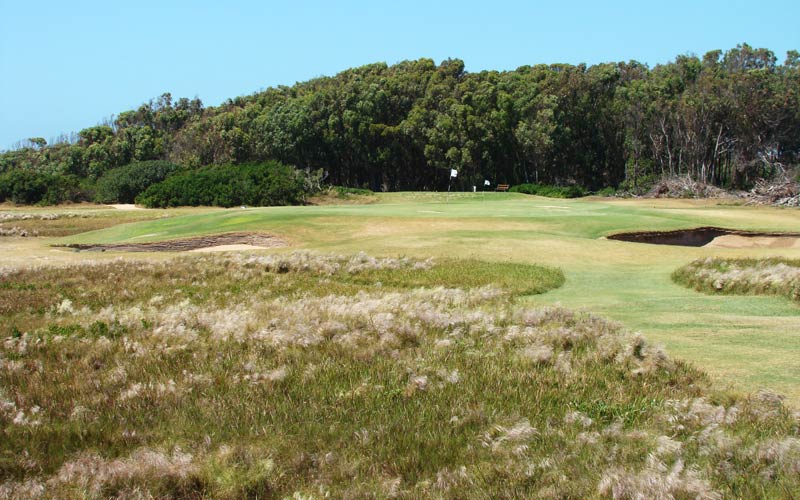
So simple in appearance yet so elusive to hit: the tabletop sixth green at Humewood. On this particular day, the winds came off Algoa Bay, providing an unusual left to right crosswind.
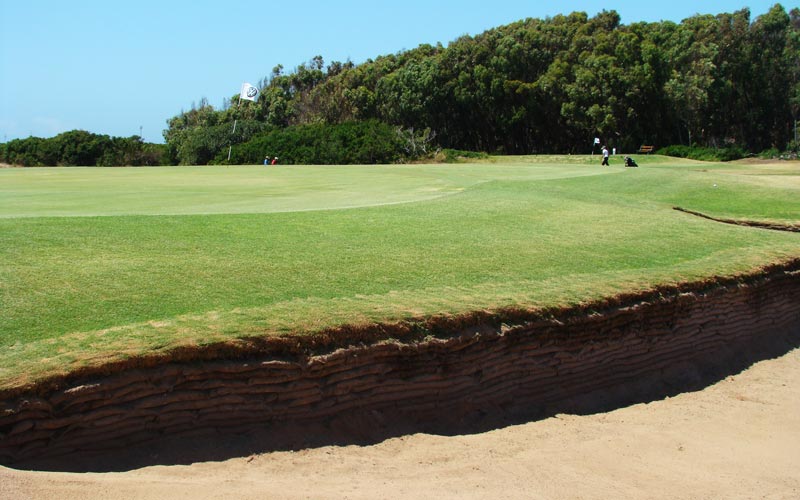
As the two photographs above show, Hotchkin provided no containment mounds or any other means to help the golfer hit – and hold – the sixth green as the ground slopes away on all sides. The only good news is that once one finds the putting surface, one shouldn’t three putt.
Tenth hole, 465 yards; Those who love links golf will have an immediate and strong affection for Humewood as they quickly grasp the subtle playing nuances offered by its crumpled landscape. Here at the tenth, though there are no bunkers from tee to green, the one to three foot humps and bumps that litter the length of the fairway ensure that it rarely plays the same way twice in a row. One day, one’s tee ball may finish slightly below one’s stance and the next it is just as likely to finish slightly above it. In that manner, the golfer is constantly forced to make tweaks and adjustments in his stance to compensate for the wide variety of lies.In this manner,a game remains forever fresh at Humewood, even for those members that have played it for decades.
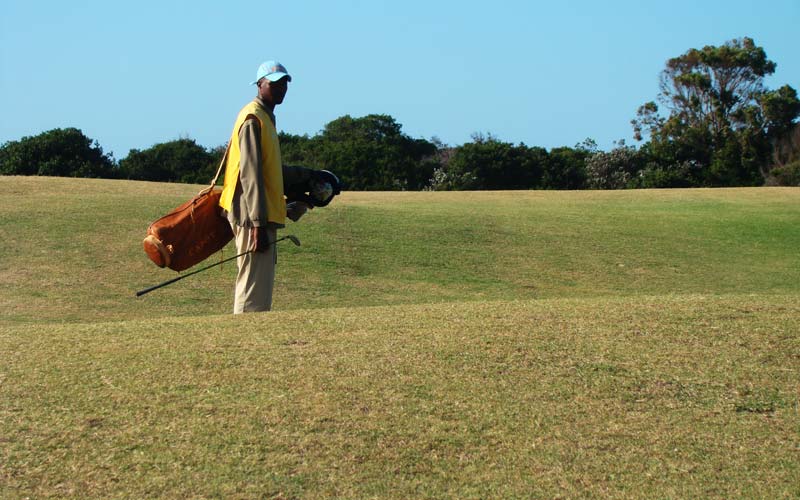
Hotchkin was an enormous fan of The Old Course at St. Andrews, so it comes as no surprise that he made the point to capture within the tenth fairway these natural rolls which are so highly reminiscent of those from his favourite Scottish course.
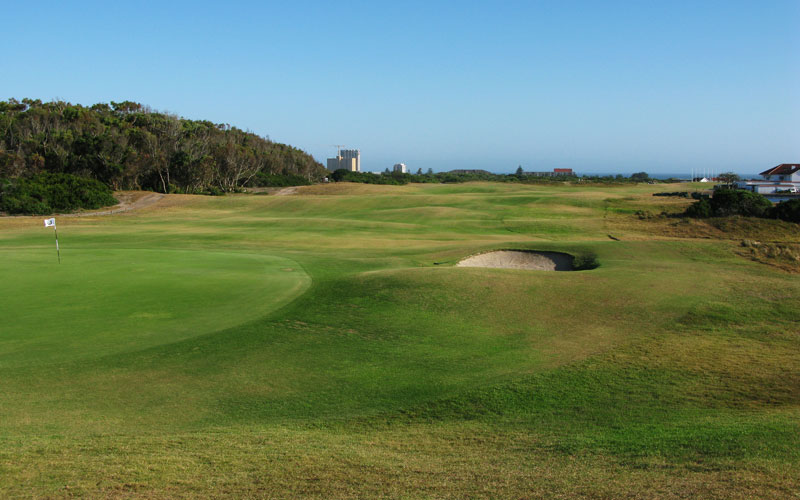
Looking back down the long tenth, the golfer appreciates the rumpled landscape.
Twelfth hole, 170 yards; The benefits of building a course on a naturally sandy site are immense. In part, it is the least expensive medium on which to build a course and the grasses that can be cultivated in sandy soil are typically well suited to promoting fast and firm playing conditions. The architect is also afforded a greater range in how he builds his green sites. Appreciating that variety is the mark of all great courses, this green is in stark contrast to the elevated knob of a green that we saw at the sixth. Here a four foot tall mound running the length of the green can be used to bounce balls off its tightly mown surface and onto the putting surface. Though the shot is great fun, Hotchkin couldn’t build such a green on a site featuring clay soil as there would be nowhere for the water to drain. Given the luxury of sand, Hotchkin wisely took full advantage when he created this green complex.
Thirteenth hole, 450 yards; Named by the editors of GOLF Magazine as one of the world’s five hundred greatest holes, the irony is that not one modern architect would build it today as its tiny putting surface on top of a dune would be labeled ‘unfair.’ Fortunately Hotchkin wasn’t shackled by the ill conceived notion that golf needed to be rigidly fair. All-world greens like the thirteenth at Prestwick in Scotland, the sixteenth at Deal in England and the thirteenth at Crystal Downs in the United States have had the best players gnashing their teeth for decades and this green follows suit. At only twenty yards in depth, it is easily the most shallow target on the course. Yet, a low mound that hugs the back and right of the greenhelps it play effectively larger. Judging how to scale the bank in front of this green – and perhaps use the back bank as a brake beyond – is one of the game’s great shots.
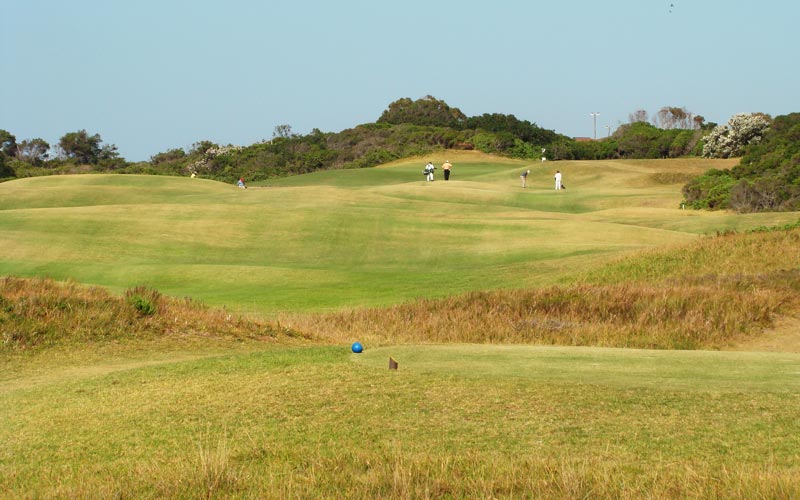
A view up the thirteenth shows a fairway full of glorious random land forms, proof positive that mother nature – and not man – creates the most enduring challenges.

Figuring out (through trial and error to be sure!) how best to find the thirteenth green is as enduring a test as is posed by any links in the United Kingdom. Note the bank beyond the green as it can be used as the golfer’s friend. The superb tight turf assures the golfer that all ground game options are available to him.
Fourteenth hole, 160 yards; Like its three predecessors, the final one shotter is of such a high standard that one wonders if Hotchkin, like Harry Colt, first located the par threes when routing his courses. This green complex was effortlessly draped on top of a natural six foot tall ridge line. Either short or long and the golfer finds himself well below the putting surface with a tough recovery. A mean little pot bunker is evident left of the green from the tee but a much deeper and bigger one is hidden behind a hill to the right. All in all, this is a particularly fine green to find from the tee.
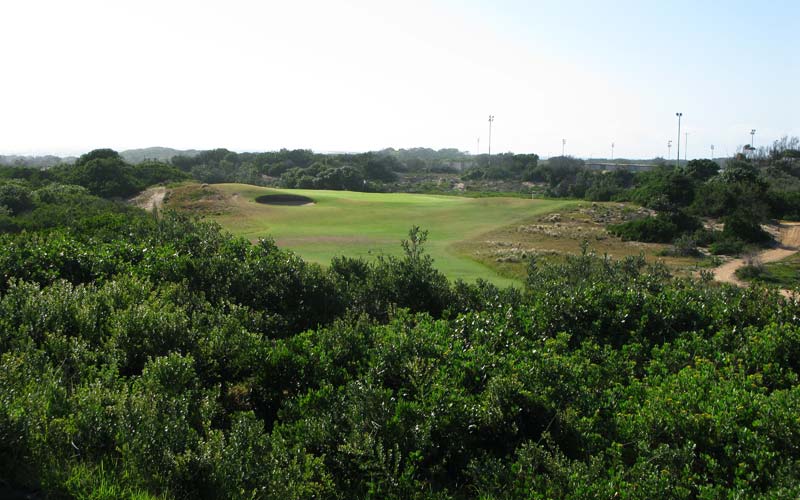
Notice how the green lies peacefully across the spine of the dune line. Its true terrors aren’t revealed from the tee, namely the steep bank over the green and the deep right greenside bunker.
Eighteenth hole, 405 yards; In the August 20th, 1929 edition of South African Golf, they wrote that ‘Major Hotchkin made the interesting statement that the terrain of this course reminded him largely of the famous Prince’s links at Sandwich. As a matter of fact, he had endeavored as far as possible to follow the lay-out of Prince’s in designing the Humewood course.’ While Humewood doesn’t have the enormous sand dunes that Prince’s next door neighbor (Royal St. George’s) does, its golfing ground is nonetheless ideally suited for golf as is proven one last time with its Home hole. Generally played into the wind, the eighteenth heads away from the sea and back toward the clubhouse, which acts as a good aiming point off the tee (the exact part depends on the wind). The Home green and greenside bunkers are the largest on the course, making for a fittingly grand conclusion.

Standing on the eighteenth tee, the golfer finds one last humpy bumpy fairway with which to contend.
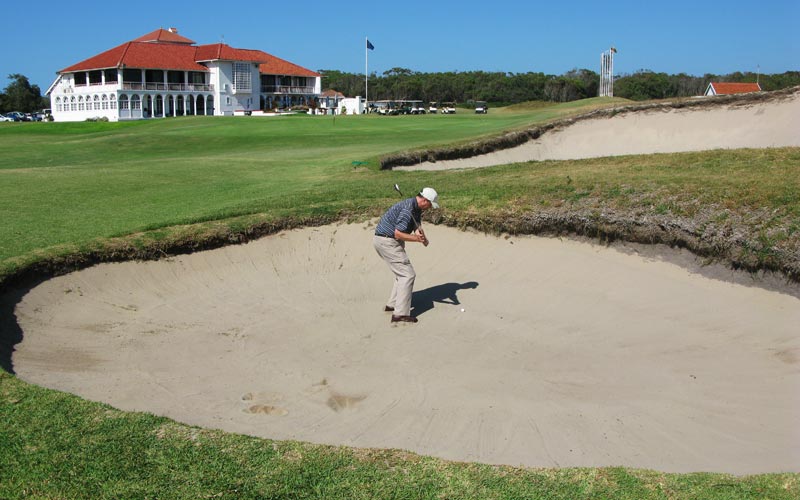
The two largest greenside bunkers are found at the eighteenth and leave awkward length explosion shots of twenty to fifty yards.

When the winds blow, Humewood’s colonial-era clubhouse affords comfy shelter as well as great views across the course and out to sea from its second story.
Great events happen at great courses, which is one of the reasons that Dr. Murray was adamant that golf course architecture be brought up to date in South Africa. One such event took place in 1952 when Syd Brews won his eighth and final South African Open on the day before his fifty-third birthday. Though not a name familiar to many in North America as his playing career preceded Bobby Locke’s and Gary Player’s, he first put South Africa on the golfing map. In near gale force winds at Humewood that day, Brews was the only man who broke eighty in either of the last two rounds.Indeed his final nine holes was played in one under par in winds that breached 40 mphs and his closing rounds of 78 and 75 are the stuff of legends.
Hotchkin would have been proud had he been there but he never returned to South Africa after his groundbreaking 1929 trip. According to MacWood’s January, 2008 article in the very fine Golf Architecture magazine, ‘From Port Elizabeth, Hotchkin would travel to Durban, Johannesburg, the Reef coast, the Cape peninsula, East London, Port Alfred and then back to Port Elizabeth. During his two month stay he would design three new courses (Humewood, Kloof and The Strand), and propose the reconstruction of an amazing 19 others.’ This included transforming Durban and East London into world class courses as well. However, it all started here at Humewood and from his arrival in 1929 to Charles Hugh Alison’s death in Johannesburg in 1952, South Africa finally got to enjoy its own Golden Age of golf course architecture. Though big name modern golf professionals like Gary Player, Jack Nicklaus and Ernie Els continue to leave their mark on golf design in this country, the simple pleasures of man battling nature in an environment where man’s hand was light upon the land continue to enthrall another generation of golfers. Indeed, one wonders that Bobby Locke might still stand behind his statement that Humewood isthe finest course in South Africa.
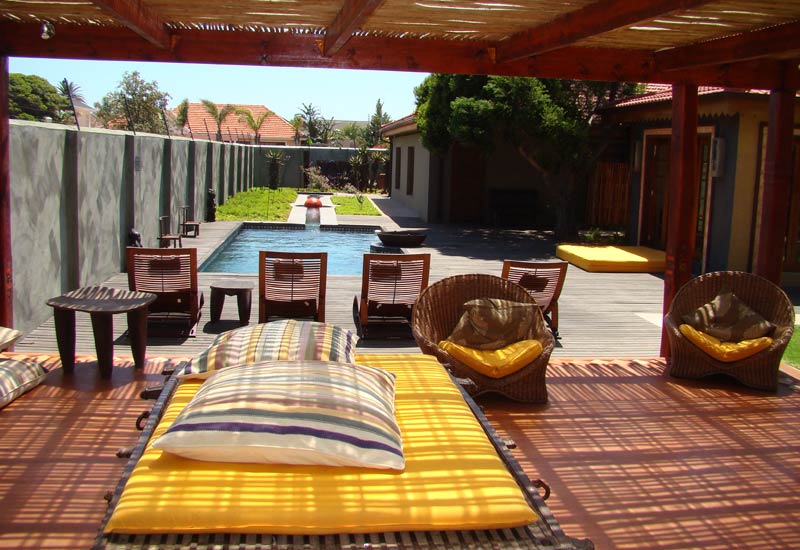
Located five minutes from Humewood Golf Club, the newly opened Singa Lodge (www.singalodge.com) comes highly recommended as a place to stay in Port Elizabeth.



